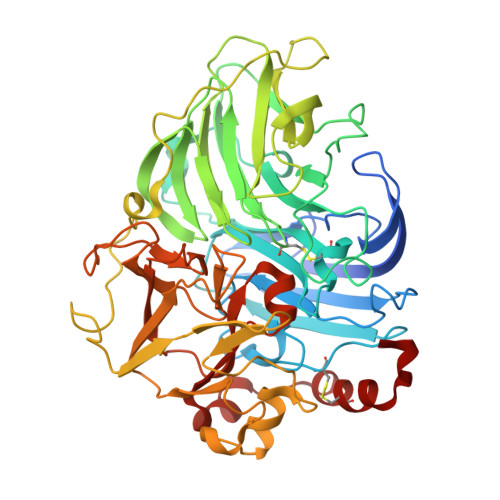Structural studies of two thermostable laccases from the white-rot fungus Pycnoporus sanguineus.
Orlikowska, M., de J Rostro-Alanis, M., Bujacz, A., Hernandez-Luna, C., Rubio, R., Parra, R., Bujacz, G.(2018) Int J Biol Macromol 107: 1629-1640
- PubMed: 29055703
- DOI: https://doi.org/10.1016/j.ijbiomac.2017.10.024
- Primary Citation of Related Structures:
5NQ7, 5NQ8, 5NQ9 - PubMed Abstract:
Laccases are enzymes that have the ability to catalyze the oxidation of a wide spectrum of phenolic compounds with the four-electron reduction of molecular oxygen to water. The active site of those proteins contains four copper ions, classified into three types. Laccases are interesting enzymes for study from the point of view of their structure, function and application because of their role in lignin degradation. Structural studies of two thermostable laccases produced by the strain Pycnoporus sanguineus CS43 (PsLacI and PsLacII) were performed. Both isoforms of PsLac show high thermal stability, at 60°C and 50°C, respectively, and they remained active at a high concentration of organic solvents. However, PsLacI has a higher thermal and pH stability and tolerance against inhibitors, and is a more efficient catalyst for ABTS and DMP (laccases substrate) than PsLacII. Based on the determined crystal structures we achieved insights into the structural factors relevant for the enzymatic properties of PsLacI and PsLacII. N-glycosylation site Asn354, which is very often present in structures of fungal laccases from other species, was not present in PsLac. This observation may be of particular significance due to the close distance between Asn354 and the substrate-binding pocket. This results in better access to the hydrophobic cavity for a particular substrate. Furthermore, we identified significant differences in the region of substrate-binding pocket, which confer PsLacI a markedly better performance than PsLacII.
- Institute of Technical Biochemistry, Faculty of Biotechnology and Food Sciences, Lodz University of Technology, 90-924 Lodz, Stefanowskiego 4/10, Poland.
Organizational Affiliation:
























